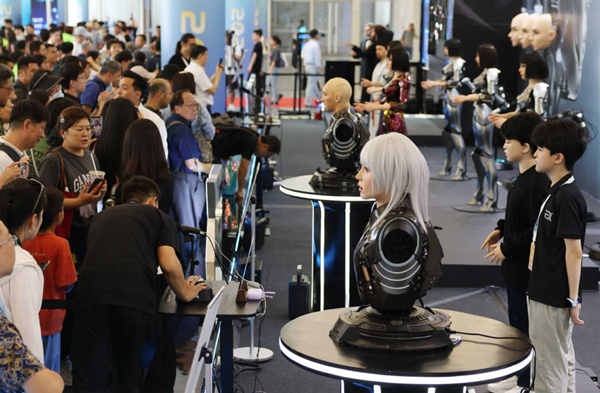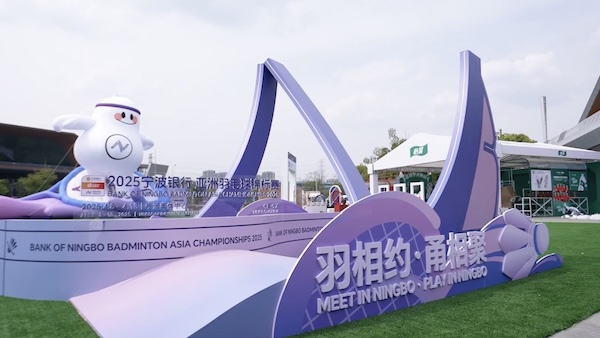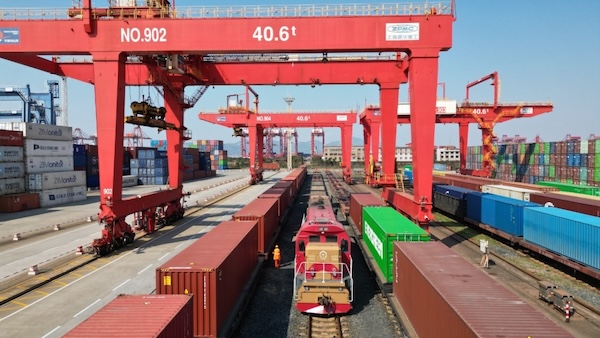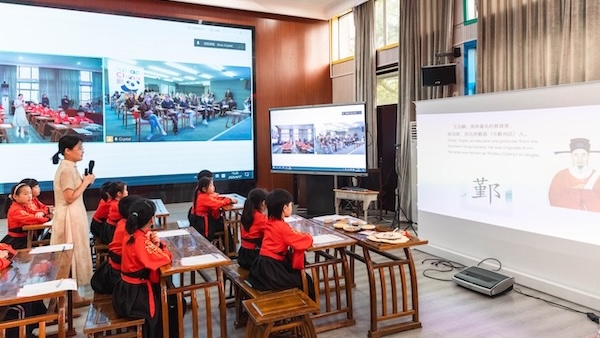China's humanoid robots advance automation

Visitors gather around humanoid robots on display during an industry expo in Beijing. LI MUYI/FOR CHINA DAILY
In Ningbo, East China's Zhejiang province, Chinese new energy vehicle manufacturer Zeekr, which is part of Geely Holding Group, a prominent automaker, welcomed its first humanoid robot "intern" to its factory recently.
With a height of 170 centimeters and clad in sleek silver, the robot extended its lightweight arm, picked up and carried a crate of automotive parts weighing 15 kilograms, and navigated through narrow aisles and around obstacles with the grace of a seasoned worker.
As it moved through the factory, Walker S, the humanoid robot developed by Chinese artificial intelligence and humanoid robotics company UBTech Robotics, notched up a first: it became the first of its kind in China to carry out full-process handling tasks at an automotive factory.
At the World Robot Conference held in Beijing in late August, 27 such humanoid robots made by different companies, including UBTech, created a splash as many Chinese companies announced they are accelerating efforts to commercialize humanoid robots, especially for industrial applications.
As these humanoid robots begin their real-world training in factories, the scene appears straight out of the sci-fi realm — cyberpunk future, it can be said, is starting to take shape. The hum of these robots at work is the sound of the manufacturing sector's next era, where human-robot collaboration is not just a possibility but an emerging reality.
Xu Xiaolan, former vice-minister of industry and information technology and a member of the Standing Committee of the Chinese People's Political Consultative Conference National Committee, said that humanoid robots are expected to become another "disruptive product" after computers, smartphones and new energy vehicles.
"Currently in China, new technologies, products and formats represented by humanoid robots and general artificial intelligence are thriving and becoming the pinnacle of global technological innovation, a new track for future industries and a new engine of economic growth," she said.
Coincidentally, August also saw foreign automotive giants like Tesla and BMW introducing their first humanoid robot "employees" in the assembly lines. Tesla boss Elon Musk has even predicted that the ratio of humanoid robots to humans in the electric carmaker's workforce will eventually reach 1:1 at least.
According to market consultancy Coherent Market Insights, China's humanoid robot market is rapidly growing and is expected to clock $2.9 billion in sales revenue this year, and is projected to skyrocket to around $46.31 billion by 2031, at a staggering compound annual growth rate of 48.6 percent.
Jiao Jichao, vice-president and executive dean of UBTech's research department, said the company is confident that its humanoid robots will achieve widespread factory applications within three years. "The company aims to deliver humanoid robots in small quantities to industries, especially automobile factories, for handling and sorting tasks, by the end of this year."
From next year to 2027, such humanoid robots will be gradually used for assembly tasks and on-site operations. Besides the automotive industry, the company will deploy such robots in 3C, or computer, communication and consumer electronics fields, as well as the logistics sector.
"During this period, we aim to achieve larger-scale commercial mass production. Here, mass production not only involves a quantity increase, but also improvements in quality, cost control and operational efficiency," he said.
By 2033, the company's humanoid robots are expected to perform more precise assembly work, such as assembling interiors and wiring harnesses, as well as assembling smaller and more delicate products like smartphones and smartwatches in the 3C industries, he said.
His comments came as UBTech officially signed a cooperation agreement with Audi FAW and the Beijing Embodied Intelligence Robotics Innovation Center to jointly develop intelligent solutions for humanoid robots, at the World Robot Conference last month.
The cooperation will drive humanoid robots into automotive production lines for intelligent material handling, quality inspection and process material operations. This is expected to promote large-scale deployment of humanoid robots in car factories.
According to a guideline from the Ministry of Industry and Information Technology, China aims to establish a preliminary innovation system for humanoid robots by 2025. By 2027, the country will see a secure and reliable industry and supply chain system, and related products will be deeply integrated into the real economy.
To sharpen the edge of future industries including humanoid robotics, China will launch a series of scientific research projects, establish a number of incubators, support certain regions to explore and develop application scenarios, and cultivate more industrial high-fliers, said Jin Zhuanglong, minister of industry and information technology, at a news conference in July.
The National Development and Reform Commission also issued a document in June and encouraged the development of humanoid robots based on large-scale AI models to enrich consumption scenarios.
Rick Xiong, general manager of the Beijing Embodied Intelligence Robotics Innovation Center, said: "These combined efforts will shape the future in our favor. Chinese robot companies have the right timing, the right place and the right people to accelerate the humanoid robot push."
Xiong said that leading Western countries have witnessed deep-pocketed industry giants dominating the robot landscape, whereas China is characterized by a proliferation of small to medium-sized enterprises striving to navigate the competitive terrain of humanoid robots.
He also said the rise of AI large language models, exemplified by technologies like ChatGPT, has been a game-changer in the robotics industry.
Traditionally, robots were limited to executing pre-programmed commands and struggled with understanding natural language. However, the integration of advanced AI models has "unlocked "new capabilities, allowing robots to comprehend and act on human language instructions — ushering in what is broadly referred to as embodied intelligence, he said.
Wang Xingxing, CEO and founder of Unitree Robotics, is also optimistic about the commercialization of China's robotics industry, and predicted that within three to four years — certainly no more than five — the industry will experience its "iPhone moment".
He said this will be the point when humanoid robots become a staple in industrial and service sectors, driving a dramatic increase in production and adoption.
For now, while humanoid robots may still seem somewhat limited in their capabilities, the pace of development suggests that this perception will soon change.
Wang speculated that by the end of this year, we might see the first general-purpose robot AI model emerge, setting the stage for a new era of robotics.
Chen Jia, a researcher at the International Monetary Institute, which is part of Renmin University of China, said, "Humanoid robots will be an industry field with great growth potential in the next decade, driven by the latest technological advancements in AI."
At the World Robot Conference last month, Hangzhou-based robotics firm Unitree Robotics said that its G1 humanoid robot has just been updated, transforming it into a version that can be mass-produced, with stronger performance and an even better appearance.
The humanoid robot, priced at 99,000 yuan ($13,910), which is considered very reasonable, can simulate human hand movements with remarkable precision, making it one of the most affordable options in the market.
What sets the Unitree G1 apart is its price point. In comparison, Tesla's humanoid robot Optimus is projected to have an ideal price of $25,000, making Unitree's offering significantly more cost-effective. This pricing strategy could accelerate the adoption of humanoid robots across various industries in China.
Marina Bill, president of the International Federation of Robotics, said about 60,000 industrial robots were installed in China 10 years ago, and their number has gone up to 290,000 now. "Hardly any other country in the world has had that quick a development."
China is by far the fastest-growing robot market in the world, with the highest number of annual installations, and it has had the largest operational stock of robots each year since 2016, according to the IFR.
"China's rapid growth shows the power of its investment so far, but it still has much greater potential in terms of automation," Bill said.

 Ningbo seabird project seeks international volunteers
Ningbo seabird project seeks international volunteers  Jakub's journey: From shipyard to sea
Jakub's journey: From shipyard to sea  Badminton Asia COO applauds Ningbo
Badminton Asia COO applauds Ningbo 


